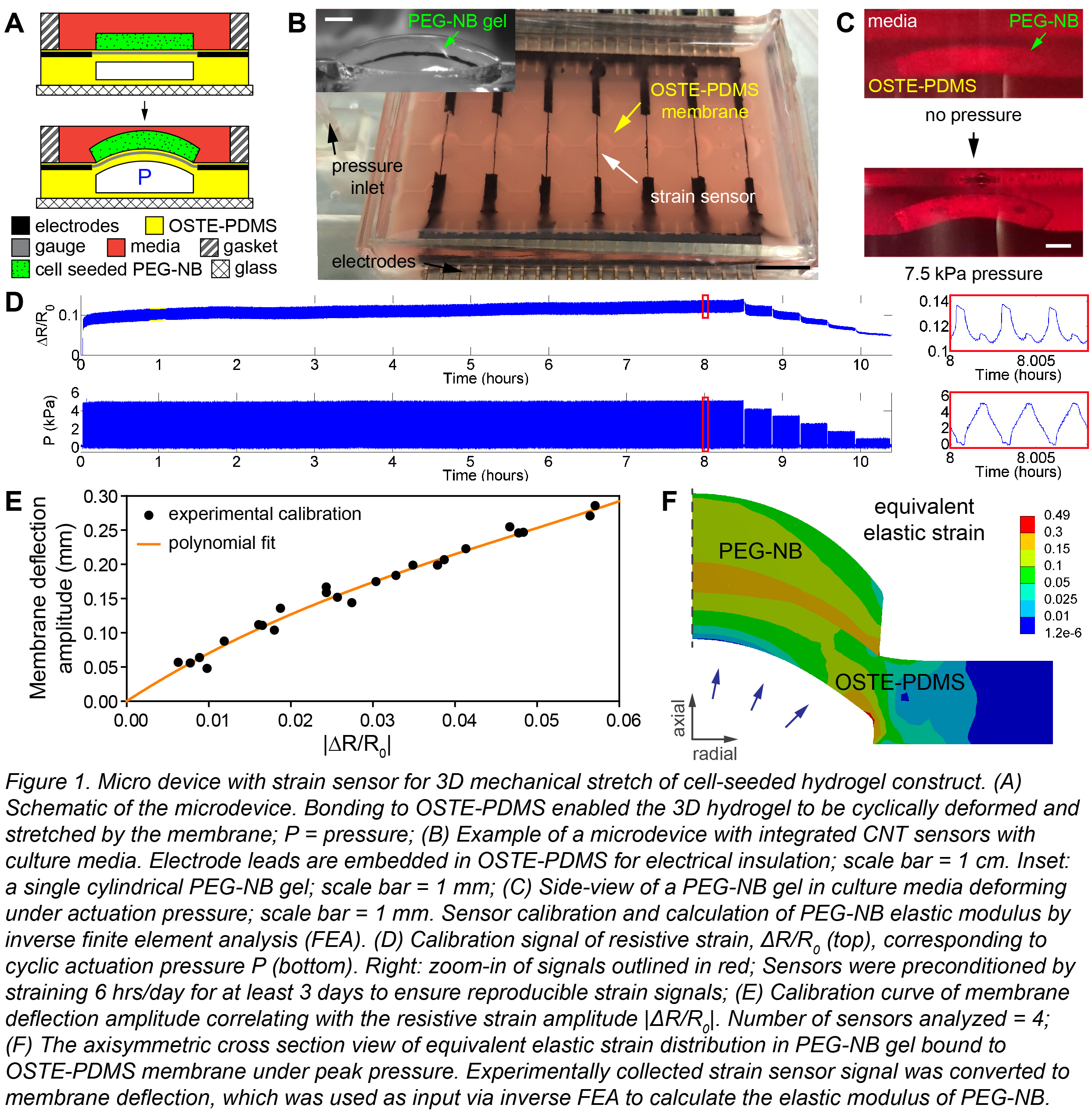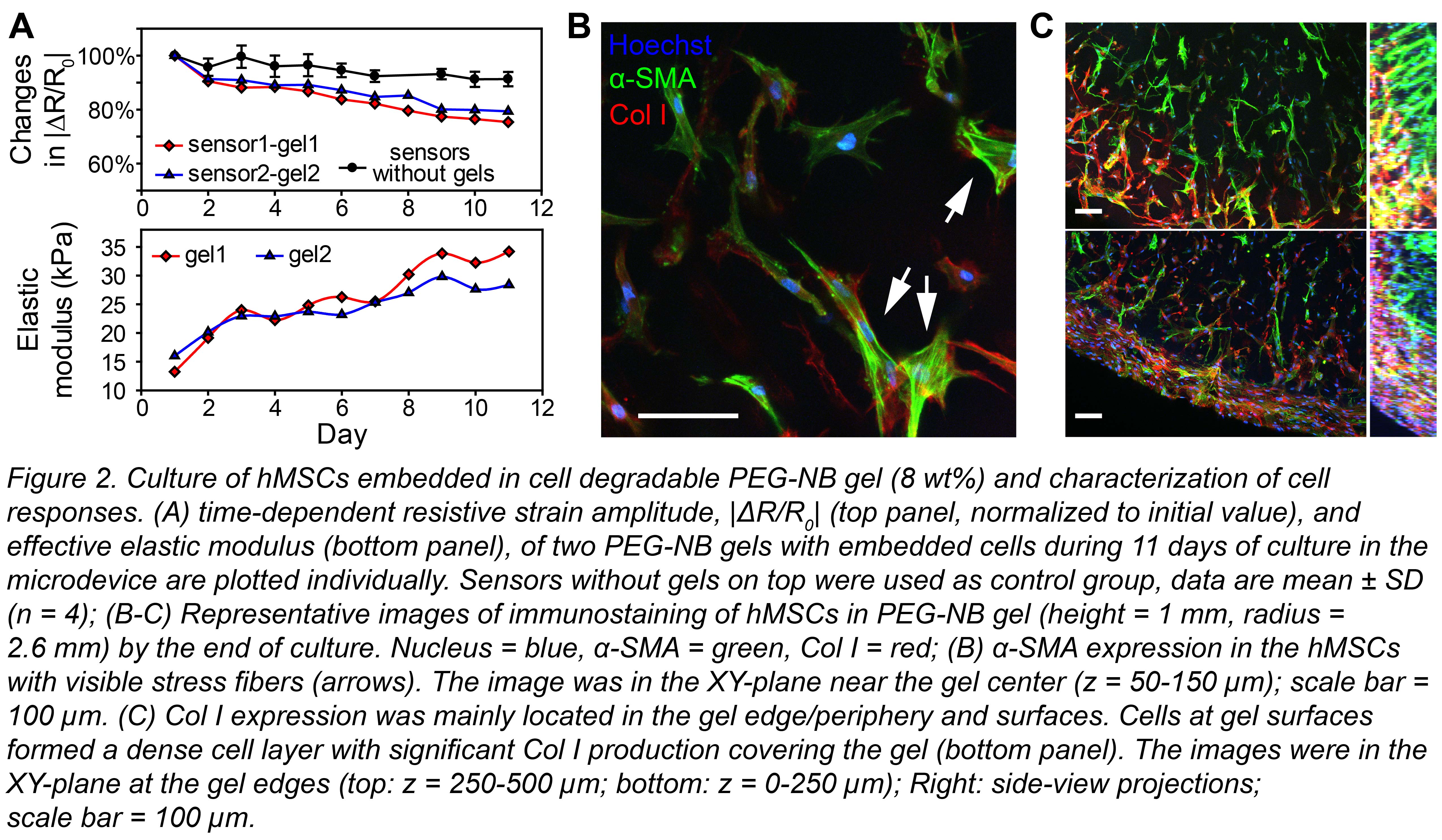A microfabricated platform with hydrogel arrays and on-chip strain sensing for mechanical stimulation of 3D cell-seeded hydrogels
-
1
University of Toronto, Mechanical and Industrial Engineering, Canada
-
2
University of Toronto, Institute of Biomaterials and Biomedical Engineering, Canada
Introduction: Cellular microenvironments present cells with multiple stimuli, including not only biochemical and matrix cues but also mechanical factors[1]. Biomaterial arrays enable systematic screening of the combined effects of microenvironmental cues on cell function[2], but these array platforms typically fail to include the effects of dynamic mechanical stimulation, which is relevant to native and engineered connective and cardiovascular tissues. To address this need, we present a deformable membrane array that enables complex mechanical loading to cells embedded in 3D hydrogel constructs and has on-chip strain sensors for continuously monitoring of the samples’ stiffness.
Materials and Methods: Stretching soft hydrogels is a challenge addressed by using off-stoichiometry thiol-ene based polydimethylsiloxane (OSTE-PDMS)[3] membranes to covalently bond polyethylene glycol norbornene (PEG-NB) hydrogels, a clinically-relevant model biomaterial with tunable properties[4], via a thiol-ene reaction (Fig.1A-C). Blends of carbon nanotube (CNT) and PDMS exhibit strain-dependent resistivity[5] and are patterned as strain sensors to monitor the membrane deflection. Sensors were preconditioned to ensure reliable strain signals, then calibrated with experimentally measured membrane deflection (Fig.1D-E). Mesenchymal stromal cells (MSCs) embedded in PEG-NB were cultured and stimulated (17% max strain, 0.1 Hz, 10 hrs/day) for 11 days. The resistive strain amplitude |ΔR/R0| was used to calculate sample elastic modulus by inverse finite element analysis (Fig. 1F). To assess the 3D mechanical stimulation effect, MSCs were stained for α-smooth muscle actin (αSMA) for myofibroblast differentiation and collagen type I (Col I) for collagen production.

Results and Discussion: PEG-NB gels remained firmly attached to and deformed elastically with the OSTE-PDMS membranes up to at least 40% strain under tensile stretching (Fig. 1C). The CNT sensors were able to measure the elastic modulus of non-degradable PEGNB gels with stiffnesses up to 30 kPa. Mechanically-stimulated cell-seeded PEG-NB gels stiffened during culture, as evidenced by a 20% decrease in the time-dependent |ΔR/R0| (Fig. 2A top), in comparison with less than 10% reduction in |ΔR/R0| for the control sensors without gels. This corresponded to a ~2-fold increase in the elastic modulus of the stimulated gels from ~15 to ~30 kPa (Fig. 2A bottom). Cells within the mechanically-stimulated gels were spread throughout the gel volumes and expressed αSMA with visible stress fibers, indicating myofibroblastic differentiation (Fig.2B). Abundant collagen was evident in the gel peripheries (Fig. 2C).

Conclusion: MSCs embedded in PEG-NB gels and subjected to dynamic mechanical stimulation undergo myofibroblast differentiation and synthesize collagen, leading to gel stiffening. This system can be scaled up to larger arrays to enable systematic screening of 3D microenvironmental cues on cell function and tissue formation in vitro.
References:
[1] K. Lau et al., Nat. Cell Biol., 2015
[2] C. Moraes et al., Integr. Biol., 2011
[3] C.F. Carlborg et al., Lab Chip, 2011
[4] E.H. Nguyen et al., Biomaterials, 2014
[5] L. MacQueen et al., Lab Chip, 2012
Keywords:
Hydrogel,
stem cell,
Bio-MEMS,
mechanical property
Conference:
10th World Biomaterials Congress, Montréal, Canada, 17 May - 22 May, 2016.
Presentation Type:
New Frontier Oral
Topic:
Regenerative medicine: biomaterials for control of tissue induction
Citation:
Liu
H,
Sun
Y and
Simmons
CA
(2016). A microfabricated platform with hydrogel arrays and on-chip strain sensing for mechanical stimulation of 3D cell-seeded hydrogels.
Front. Bioeng. Biotechnol.
Conference Abstract:
10th World Biomaterials Congress.
doi: 10.3389/conf.FBIOE.2016.01.01772
Copyright:
The abstracts in this collection have not been subject to any Frontiers peer review or checks, and are not endorsed by Frontiers.
They are made available through the Frontiers publishing platform as a service to conference organizers and presenters.
The copyright in the individual abstracts is owned by the author of each abstract or his/her employer unless otherwise stated.
Each abstract, as well as the collection of abstracts, are published under a Creative Commons CC-BY 4.0 (attribution) licence (https://creativecommons.org/licenses/by/4.0/) and may thus be reproduced, translated, adapted and be the subject of derivative works provided the authors and Frontiers are attributed.
For Frontiers’ terms and conditions please see https://www.frontiersin.org/legal/terms-and-conditions.
Received:
27 Mar 2016;
Published Online:
30 Mar 2016.
*
Correspondence:
Dr. Haijiao Liu, University of Toronto, Mechanical and Industrial Engineering, Toronto, ON, Canada, haijiao.liu@mail.utoronto.ca
Dr. Craig A Simmons, University of Toronto, Mechanical and Industrial Engineering, Toronto, ON, Canada, c.simmons@utoronto.ca